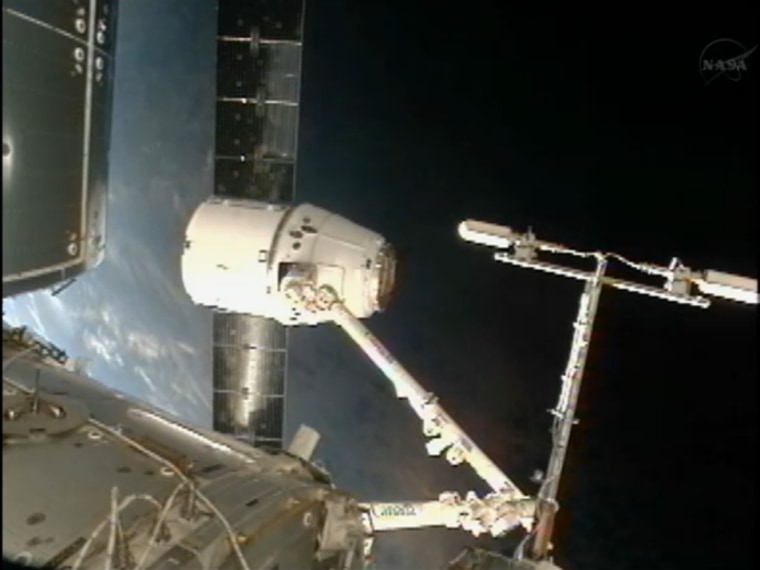A privately built robotic space capsule arrived at the International Space Station early Wednesday, making the first routine commercial cargo delivery to the orbiting lab under a billion-dollar deal with NASA.
The unmanned Dragon spacecraft was captured by station astronauts using the outpost's Canadian-built robotic arm after an apparently flawless approach by the cargo-laden space capsule, which was built by the private spaceflight company SpaceX. It is the first of 12 resupply flights SpaceX will fly for NASA under a $1.6 billion deal.
"Looks like we've tamed the Dragon," station commander Sunita Williams said as the spacecraft was grappled. "We're happy she's onboard with us. Thanks to everyone at SpaceX and NASA for bringing her to us … and the ice cream."
The astronauts' chocolate-vanilla swirl ice cream, a rare treat for the space station crew, was a last-minute item packed along with the nearly 1,000 pounds (450 kilograms) of supplies riding up to the orbiting lab on the Dragon capsule. [Photos: SpaceX's Dragon Arrives at Space Station]
The SpaceX spacecraft was captured at 6:56 a.m. ET by Japanese astronaut Akihiko Hoshide as the space station soared 250 miles (402 kilometers) above the Pacific Ocean, just west of Baja California. The capsule was attached to an Earth-facing docking port on the station at 9:03 a.m. ET.
The Dragon's hatch was scheduled to be opened on Thursday — but because the tasks associated with the hookup went so quickly, the astronauts opened the hatch early and got a sneak peek inside the Dragon on Wednesday.
SpaceX launched the Dragon spacecraft into orbit on Sunday atop the company's Falcon 9 rocket from its pad at Cape Canaveral Air Force Station in Florida. It is expected to spend at least three weeks linked to the space station and be filled with nearly 2,000 pounds (900 kilograms) of blood samples, other experiments and station gear for the return trip to Earth.
"This is a big moment in the course of this mission and for commercial spaceflight," said SpaceX CEO Elon Musk, the billionaire entrepreneur who founded the company in 2002. "We are pleased that Dragon is now ready to deliver its cargo to the International Space Station."
SpaceX officials watched over the Dragon capsule's arrival from the company's mission control center in Hawthorne, Calif., while NASA monitored the orbital rendezvous from its station Mission Control at the Johnson Space Center in Houston. The spacecraft is expected to splash down in the Pacific Ocean near Southern California on Oct. 28.
The Dragon was a welcome sight for the space station's crew. "It's nice to see Dragon flying over the U.S.," Williams said during the space rendezvous.
With NASA's space shuttle fleet retired, the space agency is relying on private spacecraft to ferry supplies and astronaut crews to and from the International Space Station. SpaceX's Dragon is the first American spacecraft to launch to the space station since NASA's final shuttle mission in July 2011.
Wednesday's Dragon arrival followed up on the success of a May test flight to the station by SpaceX, a demonstration mission that proved the company's space capsules could rendezvous with the orbiting lab and return home safely.
SpaceX is one of two companies with a NASA contract for unmanned cargo delivery missions. The other company, Virginia-based Orbital Sciences Corp., has a $1.9 billion contract for eight resupply missions using its new Antares rocket and Cygnus spacecraft. Orbital's first rocket test flight is expected later this year.
SpaceX is also developing a manned version of its Dragon spacecraft. The company is one of four spaceflight firms pursuing private space taxis to serve NASA's need to fly astronauts to and from the International Space Station.
This report was updated by NBC News. You can follow Space.com managing editor Tariq Malik on Twitter and Space.com on Twitter . We're also on and .
